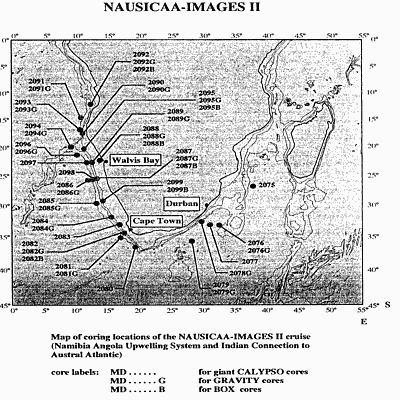1996 - Marion du Fresne Cruise MD105
 MD105 - NAUSICAA - IMAGES-II program
MD105 - NAUSICAA - IMAGES-II program
MTU participant: Laser
The second cruise of the new French research vessel, the Marion Dufresne, was also the second cruise of the IMAGES-II Programme, the aim of which was to explore the history of the Indian Ocean-Atlantic Ocean connection and of the southeastern Atlantic upwelling region over the last 300 000 years in the Late Quaternary. To this end, 24 giant piston cores. with an average length of 32 m, were recovered from the ocean basins and the continental slope and rise off southern Africa between Durban (South Africa) and Lobito (Angola). The cores off the east coast of South Africa were predominantly foraminiferal and coccolith oozes with thin quartzose turbidites at intervals. Off the west coast of South Africa, the predominant lithology was the same, but turbidites were absent and the amounts of organic matter increased equatorwards toward the main upwelling cell of the Benguela ecosystem off southern Namibia. The imprint of upwelling was most clearly seen off Namibia in the abundance of organic matter, the presence of hydrogen sulphide, and the preservation of diatoms. Sea-level fluctuations led to seaward excursions of the upwelling cell during lowstands (glacials), when abundant organic matter was deposited on the slope and rise and landward shifts during highstands (interglacials like those of today), when the upwelling zone moved back onto the shelf. North of the Walvis Ridge, the Kunene and Angola margin is dominated by organic- and diatom-rich terrigenous muds, very distinct from the carbonate-dominated oozes off Namibia and South Africa.
